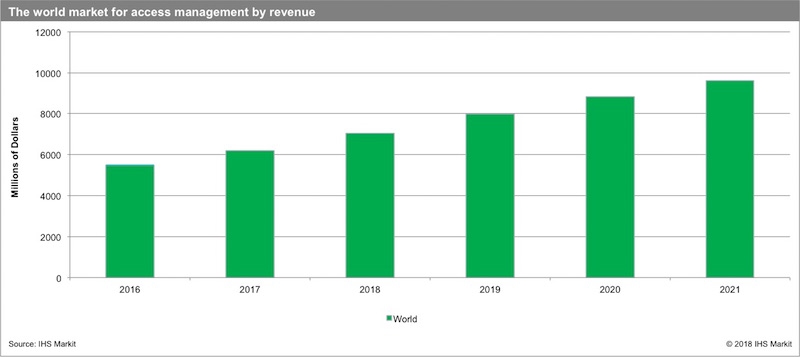
Headlines
News
IHS Markit: access management global revenue to reach near $10 billion
According to an IHS Markit report, access management global revenue is projected to increase from $5.4 billion in 2016 to $9.6 billion in 2021.
January 24, 2018 By SP&T Staff

The key access management growth factors over the next five years include the following:
GDPR deadline fast approaching: The increase in the number of data breaches and the looming legislation around General Data Protection regulation (GDPR) in May 2018 has also piqued renewed interest in security and identity and access management solutions.
Smaller organizations using access management solutions: Access management solutions have traditionally been deployed by larger organizations.
In fact, “companies with 5,000 or more employees are projected to contribute the largest revenue growth over the next five years, increasing from $4.38 billion in 2016 to $5.4 billion in 2021. The proportional importance of this segment is predicted to decline from 80 per cent of total access management revenue in 2016 to around 56 per cent in 2021.”
Small and medium-sized enterprises (SMEs) will increase the amount of access management solutions they deploy. Revenue from companies with between one and 499 employees is projected to increase from $109.6 million in 2016 to $705 million in 2021.
The report adds that the introduction of more cloud solutions within the access management market is likely to help SMEs, in particular, because cloud-based access management solutions can be more cost-effective and scalable for them.
On-premises hybrid and cloud solutions: Since many applications still run on premises at companies, a significant portion of larger organizations still want some on-premises solutions. Larger organizations are more likely to move to a hybrid model, IHS Markit predicts.
Hybrid solutions are projected to increase from $1.1 billion in 2016 to $1.7 billion in 2021. However, smaller organizations are more likely to deploy software-as-a-service solutions.
Technological developments and the battle with hackers: As a result of the pervasiveness of hacking, organizations have to account for people’s locations, to help detect fraudulent activity and ensure the right people have the right access. Technologies like machine learning and AI are important in this.
Additionally, the report says leveraging emerging technologies, such as behavioural biometrics, will help reduce the burden on end-users and increase the validity of identity proofing.
Blockchain makes security cheaper and more accessible: “Many organizations have isolated and centralized identity management systems, but the current landscape demands federation and single sign-on (SSO),” says IHS Markit.
These systems make identity management, protection and verification costly and risky for industry enterprises and government agencies, the report claims.
However, “Blockchain has the potential to introduce improvements that can make security more accessible and budget friendly.”
With smart contract capabilities, a secondary market could emerge where users benefit from sharing resources back to the network.
According to the report, a permissioned blockchain technology provides core capabilities that enable a trusted digital identity network to build and operate the following:
• A shared, append-only ledger, with one version of the facts shared across all permissioned network participants in real time
• Smart contracts that ensure verifiable and signed business logic is executed in each transaction
• Trust between known participants to verify transactions and ensure valid records
• Privacy and security measures that grant access only to permissioned parties
Print this page